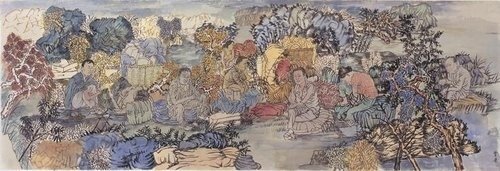Yun-Fei Ji
dal 18/2/2010 al 26/3/2010
Segnalato da
18/2/2010
Yun-Fei Ji
James Cohan Gallery, New York
Mistaking Each Other for Ghosts. Ji revisits the treasure chest of the folk legends he grew up with while exploring texts including Strange Tales from a Chinese Studio, a collection of ghost stories by the 18th century author Pu Songling.

James Cohan Gallery is pleased to announce the second exhibition by Chinese expatriate artist Yun-Fei Ji, opening February 19 and running through March 27. The exhibition will include new works on paper as well as Ji's artist's book, Migrants from the Three Gorges Dam, recently published by the Library Council of The Museum of Modern Art, NY.
Yun-Fei Ji was born and raised in China during the Cultural Revolution. Separated from his parents at the age of two, Ji grew up on a collective farm outside Hangzhou where, in the absence of TV and radio, he was kept entertained by his grandmother's telling of ghost stories and folk tales. Ji studied at the Central Academy of Fine Arts, Beijing, where he was trained in traditional painting techniques with mineral pigments on mulberry paper in the style of Song Dynasty landscape painting. After relocating to the United States in 1985 on a fellowship from Fulbright Collage, Arkansas, Ji found his voice as an artist who reinvents the system of symbolic structures found in classical Chinese painting to expose the dark side of industrial development on contemporary life. As Ji states, "I use landscape painting to explore the utopian dreams of Chinese history, from past collectivization to new consumerism."
In his new work, Ji continues to reference the historical in order to connect with the contemporary. Ji revisits the treasure chest of the folk legends he grew up with while exploring texts including Strange Tales from a Chinese Studio, a collection of ghost stories by the 18th century author Pu Songling. Ji's paintings, populated by fantastical creatures, animal spirits and monstrous ghosts, take their inspiration from these tall tales to offer as subtext a critique on the fallibility and corruption of Chinese leaders throughout history. As in the ancient stories, Ji's ghosts are stand-ins, free to express themselves in ways not allowed to people living under tightly controlled social and political hierarchies.
Ji also extends his gaze to his adopted country and the disaster of Hurricane Katrina, a story of government failure and nature's fury. His visit to Louisiana during the aftermath of the storm yields Ji fertile territory for new drawings filled with flooded homes, overturned vehicles, uprooted trees and displaced people.
Also on view is Ji's new artist book, Migrants from The Three Gorges Dam, which is presented in the form of a scroll. This work is another representation of Ji's continuing endeavor to portray the social and psychological upheaval caused by the building and subsequent flooding of the Three Gorges Dam on the Yangtze River in China. This 32-foot long, gradually unfolding narrative tells the story of the tragic effects of the project on those dispossessed by the Dam and the resulting loss of the rich culture from the Three Gorges region. The scroll consists of hand-printed paper mounted on silk that was made with over 500 hand carved, pear wood blocks. It was printed at the famous Rongbaozhai studio (the 'Studio of Glorious Treasures'), which was once closely associated with Beijing's imperial enclave in the Forbidden City. Rongbaozhai studio still makes prints and scrolls in the style it developed over a thousand years ago and has been declared a "rare intangible cultural property" by the Chinese government. Like Ji's paintings, this edition is populated with naturalistic and symbolic images of places, people and symbolic images, such as 'floating weeds,' a term adopted by Ji from an ancient Chinese phrase to describe displaced people, and phantasmagoric beasts dancing 'loyalty dances,' a term used by the Communists to replace the traditional term for folk dance. At end of the scroll, Ji 's calligraphy tells the long history of Chinese ambitions to tame the Yangtze.
Yun-Fei Ji received the 2006 American Academy Prix de Rome fellowship and residency, and, in 2007, was artist-in-residence at Parasol unit foundation for contemporary art London. In 2005, Ji was artist-in-residence at Yale University where he conducted extensive research with the institution's scholars. Ji's important solo museum exhibition, The Empty City, 2004, originated at the Contemporary Art Museum (St. Louis) and toured to the Rose Museum, Brandeis University, and the Peeler Art Center, DePauw University. In 2004, the exhibition Yun-Fei Ji: The East Wind was organized at the ICA, University of Pennsylvania. Ji's work has been exhibited in solo and group shows throughout the United States and Europe including the Whitney Biennial 2002. In 2008, Displacement: The Three Gorges Dam and Contemporary Chinese Art, an exhibition of four Chinese artists originated at the Smart Museum of Art, Chicago, IL and continues to tour nationally. Yun-Fei Ji lives and works in Brooklyn, NY.
Image:
© Yun-Fei Ji
Blind Stream, 2008
Watercolor and ink on Xian paper
13 1/2 X 40 1/4 inches
Opening 19 feb. 2010
James Cohan Gallery
533 West 26th Street - New York
Tuesday - Saturday, 10am - 6pm



